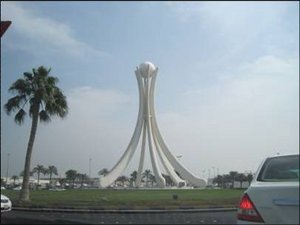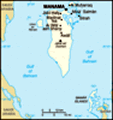Advertisement
Published: November 14th 2009

 Pearl Circle, Bahrain
Pearl Circle, Bahrain
The Pearl Circle in BahrainOur trip to Bahrain was an unexpected bonus during my sabbatical. My brother-in-law lives in Bahrain and as luck would have it, we had enough frequent flyer points with Emirates to score a return trip from Amman for JOD 36.15 (AUD 56.89) each, flying via Dubai. Tourist visas for Australians are available on arrival and cost a measly BHD 5 (AUD 14.25) each. The line up through customs took a little while (about 1/2 hour) but was trouble-free. My brother-in-law met us at the airport and we were welcomed by the warm weather.
We stayed in a new suburb of Bahrain in a three-storey apartment situated on a lagoon connected to the nearby sea. The water was perfect for swimming, but there is also a pool as part of the apartment complex. Although we were only in Bahrain for a few days (23 to 26 October), we packed in a heap of tourist adventures.
One of the staggering historical facts about Bahrain is another of the things they never taught us in school. Bahrain is commonly regarded as the ancient site of Dilmun, mentioned in the Epic of Gilgamesh (ruler of Sumer, a city-state of Mesopotamia circa 2700 BC)

 Bahrain Burials
Bahrain Burials
Bathtub sarcophagus at the museum near Qalat Al-Bahrainas the island of immortality. The island was later renamed Tylos under the rule of Alexander the Great, and was also ruled by most of the great historical powers in the region, including the Assyrians, the Arab Muslims in the earliest stages of Islam, and later the Portugese and Persians.
Bahrain is strategically located in the Persian Gulf, and was a trading hub between the Indus Valley and Mesopotamian civilisations. Historical records indicate that the island traded with Palmyra and Petra (among other cities of the Roman Decapolis) Copper, dates and later pearls were significant resources of the island. An interesting feature of Bahrain is the approximately 85,000 burial sites. For a long time it was thought that the island was used as a burial ground for nearby Saudi Arabia, but population statistics suggest that the 5,000-year history of the island accounts for the 85,000 burials from the local population alone.
We were able to visit a few not-so-local restaurants, starting with the
Meat Co. in Manama and also a French cafe and salad bar. Although the westernisation of Bahrain seems to be inevitable, most of the architecture is tastefully faithful to the Arabic style. Being able to smoke in a

 Qalat Al-Bahrain
Qalat Al-Bahrain
The fort which was reinforced by the Portuguese circa 16th Centuryrestaurant is a real blast from the past, but it may not be everyone's favourite part of dining. Not surprisingly, most of the best beef and lamb is from Australia, New Zealand, or Brazil, but what is striking is the diversity of imported foods.
Bahrain is also developing an interesting youth culture and the restaurant area had a performance of a high-tech instrument which works by the movements of the 'performer' making computer generated noises. Sounds strange but the performance drew a large crowd. One of the modern features which gets a mention in the tourist brochures is the Pearl Circle - a simple (but tall) monument in the middle of a roundabout. Why this gets a mention I will never know but you can see it here in the photos. For me, the most striking modern structure is the two buildings (somewhat Dubai-esque) which look like they were joined as we flew in but were actually separate buildings (see photo).
We went shopping in the downtown souq but found this disappointing. Most of the goods for sale were poor quality, or of little variety. We bought some walnuts still in the shell but these were imported from

 Street Art
Street Art
Street Performance in Bahrainthe US and were stale. There was a spice section which looks good, with all the variety of colours and some interesting spices we had no idea about. We also went to the gold souq which had some interesting pieces, but our experience of the gold souq in Dubai in 2006 left us cautious about purchasing jewellery outside of Amman. The super malls are also an interesting (although very Western) distraction. I think Central Mall was the biggest I have ever been in.
However, our shopping highlight was the fish market, where we purchased 2kg of prawns (BHD 2), 3 live Bahrain Bugs (BHD 5), a 3kg kingfish (BHD 5) and some squid. We organised a barbecue with my brother-in-law's friends on his balcony overlooking the lagoon. The prawns and bugs were a hit, but the fish was disappointing and we couldn't be bothered preparing the squid. The fish market stunk like nothing else, especially because there were small fish lying in the carpark in the hot sun. Inside, there was a distinct lack of ice with the fishmongers throwing cold water on their stock to keep it cool. They splashed us too many times to imagine and we

 Qalat Al-Bahrain
Qalat Al-Bahrain
Heba & Michael inside Qalat Al-Bahrainreturned home to wash our clothes. We also thought we were a bit crazy for eating seafood like this, but in the end it all worked out fine and it was worth the experience.
On the Saturday, we went to Qalat Al-Bahrain (near the site of the original city) which was reinforced by the Portuguese in the gunpowder era. The view back toward the city was amazing, and the hand-held audio guide was worth the extra pocket money. The history of the site is extraordinary, dating back to the time of the pyramids in Egypt and ancient Sumer. Bahrain is still famous for its dates and human remains show signs of dental decay from the amount of dates that were consumed as part of the typical diet. Another feature of the remains was that a few showed had fused bones, particularly the spines, as a result of the extraordinary amount of flouride in the natural springs which enabled Bahrain to be inhabited from early times. Apparently, there are freshwater springs rising from the sea bed, and this (or so local legend has it) explains the quality of the pearls which helped Bahrain prosper up until pearl farming put an

 Ruins at Qalat Al-Bahrain
Ruins at Qalat Al-Bahrain
Ruins from one of the original citiesend to the industry. While the weather at the castle was particularly hot, it was certainly worth the effort.
The following day we visited the National Museum of Bahrain which put a lot of the history into perspective, including some amazing life-size dioramas of life in Bahrain through the ages. The Museum also explained an item we had seen at the downtown souq. When we asked the young storekeeper about a cane with a red knob on one end, he shrugged his shoulders and said in Arabic, 'I don't know!' In one of the dioramas, the mystery was revealed - it was a cane used by teachers in classrooms as a pointer. We spent about two hours at the museum which enabled us to see everything in some detail. There were some interesting documents on display, including the granting of independence to Bahrain by the British in the early 20th century, and some of the oldest surviving Islamic texts and Qurans.
The rest of the time was spent swimming in the pool and the lagoon and sending postcards to friends and family. Although we missed seeing some of the other ruins at Bahrain, including a Mosque dating from

 Qalat Al-Bahrain
Qalat Al-Bahrain
View from the museumthe very early part of the Islamic calendar, we covered a great deal in a short time. It is well worth a visit and would be an ideal place to work for a short period, if only to enjoy the tax-free status for expatriates on the island.
The most striking thing for me is how an island of such historical importance is overlooked in the teaching of history. Ethnocentricity is obviously the source of the problem, but how Tylos can be mentioned in relation to the ancient Greeks but not put into a contemporary perspective bewilders me. The importance of travel in one's education simply cannot be overlooked if you want to really know about the world. Otherwise, I think you just get the story 'they' want you to hear.
Advertisement
Tot: 0.089s; Tpl: 0.012s; cc: 10; qc: 55; dbt: 0.0467s; 1; m:domysql w:travelblog (10.17.0.13); sld: 1;
; mem: 1.1mb







